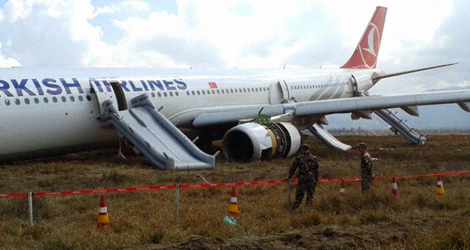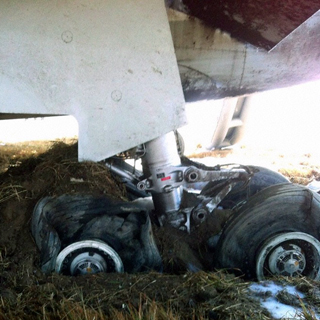Turkish Airlines flight TK726 accident took plane in Kathmandu airport (Nepal) in March 04th 2015.
The NAIC (Nepal’s Accident Investigation Commission) reported the aircraft attempted to establish radio contact with Kathmandu between 00:02Z and 00:11Z while descending to FL250 towards Kathmandu, however Kathmandu Control was not yet in operation and there was no response.

Turkish Airlines – Airbus – A330-303 (TC-JOC) flight TK726 with slides deployed
The aircraft entered a hold at FL270. The airport started operation according to its schedule at 00:15Z, the aircraft established radio contact at 00:17Z and was told, that visibility was 100 meters and the airport was shown closed.
At 00:22z the crew requested to decend and hold at Simara due to turbulence at Parsa and was cleared to hold at Simara at FL210.
At 01:05Z the airport reported the visibility had improved to 1000 meters, the crew reported ready for a RNAV approach to runway 02 and was cleared for the approach. At 01:23Z the aircraft was handed off to tower and received landing clearance at 01:24Z, but went around at 01:27z due to lack of visual reference. The aircraft followed the missed approach procedure and climbed to 10500 feet.
At 01:43Z the airport reported the visibility at 3000 meters, the crew requested another RNAV runway 02 approach and was cleared for the approach. At 01:55z the aircraft was handed off to tower and was cleared to land, winds from 160 degrees at 4 knots. Tower queried the crew whether they had the runway in sight while the aircraft was descending through 880 feet AGL with the crew replying in the negative, at 783 feet AGL the crew inquired whether the runway approach lights were on, tower affirmed the runway lights and approach lights were at full intensity.
The autopilot remained coupled until 14 feet AGL, then was disconnected and a flare was attempted. The aircraft touched down at 1.8 degrees nose up resulting in a vertical acceleration of +2.7G, the aircraft touched down to the left of the runway center line with the left main gear off the paved surface of the runway 32.1 meters to the left of the runway center line.

Main Landing gear of Turkish Airlines – Airbus – A330-303 (TC-JOC) flight TK726
The NAIC reported that another aircraft taxiing for departure reported the visibility was next to zero and returned to the apron, then heard emergency services reporting the Turkish Airlines landed on the grass.
Surveillance cameras showed the weather deteriorated during the second approach, starting at about 01:55Z when the aircraft contacted tower, and visibility became worse than during the first aproach when the aircraft was on short final and was well below required minima when the aircraft attempted to flare. There had been no transmission from tower to inform the crew about the deteriorating visibility.
The aircraft was under the command of the captain (55, ATPL, 14,942 hours total, 1,456 hours on type) assisted by a first officer (47, CPL/Frozen ATPL, 7,659 hours total, 1,269 hours on type). The captain was pilot flying.
The aircraft was equipped with a FMS database showing runway threshold 02 at 26 meters to the left of its actual position and 120 meters past the actual position. Nepal had issued an AIRAC AIP supplement on January 1st 2015 displacing the threshold by 120 meters due to planned runway extension work, the supplement valid until March 4th 2015 was cancelled by NOTAM past the AIRAC cut off date, the displacement thus remained active in the FMS database. The displaced threshold remained in the database and charts of the database provider even for the next AIRAC cycle.
The NAIC wrote: “Finally on 01 April 2015, an AIP Supplement was issued cancelling the AIP supplement S002/15 which was eventually never implemented. This means that the threshold of RWY02 was never officially and physically displaced but the NAV Database were modified.”
With respect to the 26 meters offset to the left the NAIC reported that the airline’s version used a resolution of degrees minutes and seconds to compute the runway threshold, while the AIP supplement provided the coordinates at 0.001 seconds resolution resulting in the position shift.
The NAIC annotated that the crew of the Turkish Airlines flight to Kathmandu of March 2nd, two days prior to the accident, reported the inaccuracy of the RNP coordinates stating that their aircraft was high on the approach in relation to the PAPIs and offset to the left of the center line.
The NAIC reported in their analysis that the pilot flying reported having the runway approach lights in sight at decision altitude and continued the approach, then temporarily lost sight and just before initiating the go-around became visual with the runway and continued the landing. The NAIC however concluded that the visibility was below requirements to continue the approach based on surveillance videos showing the visibility was almost zero at the time of touchdown, the testimony of other crew returning to the apron due to visibility being almost zero.
In addition the response to the “MINIMUMS” call was “Continue until 300 feet“ rather than the standard operating procedure respond “visual and continue“, the pilot monitoring also did not call out “visual“.
5 seconds prior to touchdown the pilot flying said “appearing” which was the first reference to having the runway in sight.
With respect to human factors the NAIC wrote in their analysis: “At 01:29:35 hrs, after first missed approach, a cabin attendant talked to the Captain in the Cockpit that if they diverted to Delhi, there would be a big burden.
The Captain told that weather was getting better and they could land here. At 01:30 hrs the First Officer told to the Captain that RNP Approach would bring them directly to runway. These conversations of the crews might indicate a fixation to land at Kathmandu. Four seconds before the “MINIMUMS” auto-callout, the PM stated “it will appear when we descend below…” which may have encouraged the PF to descend below the MDA even if the runway or approach lights were not visual. The PM did not question the Captain when a non-normal response to the “MINIMUMS” auto-callout was made.”
With respect to the FMS datbase the NAIC analysed: “The aircraft had been operating to Kathmandu with the amended runway threshold coordinates from 5th February to the date of the accident.
When visual contact is made with the runway or approach lights, the flight would have conducted with required visual reference below the decision height and autopilot disengaged at the decision altitude.
By flying with required visual reference and autopilot disengaged, the flight crew would have lined the aircraft up with the runway centerline. In this accident, since there appears to be no required visual reference to continue the approach below the decision altitude the aircraft should have executed a missed approach . Had there been the required visual reference the pilot has every opportunity to align the aircraft with the runway regardless of the coordinates entered into the PMGS NAV database. This type of approach is not designed to be flown on auto-pilot all the way to the threshold.”
The NAIC further analysed: “The commission collected the LIDO chart from the aircraft. The chart was based on to be displaced threshold coordinates. According to the valid LIDO chart at the date of the event required visibility minima was 1500 m. The crews were briefed at the dispatch that they used 900 m visibility minima because of the cancellation of planned displacement.”
The probable cause of this accident is the decision of the flight crew to continue approach and landing below the minima with inadequate visual reference and not to perform a missed approach in accordance to the published approach procedure.
Other contributing factors of the accident are probable fixation of the flight crew to land at Kathmandu, and the deterioration of weather conditions that resulted in fog over the airport reducing the visibility below the required minima.
Download Report

0 Comments